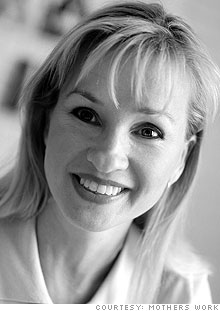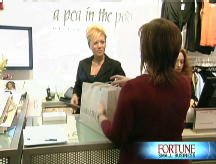Mothers Work: A feminist revolution
Fed up with "dumb bows and big buttons," Rebecca Matthias filled a maternity-wear void with professional attire for a new generation of working women - and in the process, created a retail empire.
(FORTUNE Small Business) -- It's not hard for Rebecca Matthias to remember a time when maternity clothes weren't exactly fashion-forward.
The founder and chief creative officer of Mothers Work (MWRK) - the Philadelphia company that owns maternity-wear chains A Pea in the Pod, Mimi Maternity, and Motherhood Maternity - was driven to start her business when she was pregnant with her first child. Tent dresses with garish bows and big buttons weren't appealing, so the former engineer improvised her way through the launch of a mail-order business.
Nearly 26 years later, Mothers Work leads the maternity apparel industry with $600 million in sales and more than 1,500 retail locations in the U.S. and Canada. FSB spoke with Matthias at her company's headquarters to find out how an architect of buildings became the architect of a retail empire. Below is an edited transcript of the discussion - for more, see our video on how Matthias got started.
FSB: How did you end up in the apparel business? Do you have a background in fashion design?
RM: No, I studied to be an architect. I have a degree in architecture from Columbia and a degree in civil engineering from MIT. My first job was as a construction engineer at a building in Providence. I met my husband when I was a site engineer at a building for a company he was launching. Shortly after we married we moved to Boston so he could start another company, a computer business. That's when I got pregnant and decided it was time to start my own business that I could run from home.
FSB: Why maternity clothes?
RM: A mail-order business would allow me to work from home. Now all I needed was a product. Every night we'd sit around brainstorming about what I could sell. Meanwhile, the bigger my belly got, the more I needed maternity clothes - but in 1981, 'professional' maternity clothes didn't exist.
It's very hard to reconstruct the setting back then. Women had really only started working in high-level professional careers during the 1970s. Prior to that, women weren't in the workforce in the ways we are now - you were a secretary or a teacher until you started your family, and then you were a mom. Working through your pregnancy was revolutionary. (We tend to forget that because it's so much a part of the culture now.)
All that was available for pregnant women was stereotypical froufrou stuff with really dumb bows and big buttons - it was very childish and nothing you'd wear to the office. I got through my pregnancy by buying regular clothes in larger sizes and being creative about finding things that fit. By the time I got to be six months pregnant, it was clear that there was a void in the market that I could serve by mail.
FSB: So you have the idea - but where do you go from there? How did you get started?
RM: I started small. I didn't have a lot of money. I had a budget of $10,000 that I'd put aside - it was our savings. It was scary, but I guess I felt that I could always go back and get a job. It wasn't like I was risking a huge amount of money. Ten thousand dollars went pretty far back then. I split it up: $3,000 for ads, $3,000 to produce the catalog, and $3,000 for the clothes.
I learned by doing. I didn't know how to create a catalog. I knew as a customer what I wanted to wear, but for the rest I had to get creative. I thumbed through the Yellow Pages constantly and made cold calls, asking people questions. I'd call a photographer, and he'd say, "I only do industrial photography. Try this guy." And then I'd try that guy and ask him, "By the way, do you know a printer?" I was constantly following my nose.
FSB: Where did you place the ads?
RM: National media such as the New York Times (NYT) and the Wall Street Journal. Each one-inch ad said, "Pregnant?" That was the grabber in big letters, and then it said: "Write me for your catalog of professional clothes." Lots of people seemed to want the catalog. Back in those days it was just me answering the phones, and my product hung in my front closet. When I got an order, I'd wrap it in a box and send it.
FSB: How about the clothes? That seems like another steep learning curve. Did you make them yourself?
RM: I trekked to Seventh Avenue in New York City's garment district, hauling my baby son around with me. First I did my Yellow Pages research and found some vendors who made maternity clothes - or clothes that were big enough to be considered maternity. Then I visited and bought everything on the spot: 50 pairs of pants, 50 tops, a slew of skirts. The only thing I couldn't find was a navy business suit - this was the era of the navy-blue suit and floppy red tie. I photographed my own outfit, a gray Talbots jumper and a navy Jaeger jacket that I'd worn nearly every day of my pregnancy. I dyed the jumper in my bathtub so it looked like it was made from the same shade of navy as the jacket.
FSB: Did anyone order it?
RM: Yes, and I panicked. I charged $350, which was precious revenue to me, and I had to figure out how to get it made. I went back to the Yellow Pages and found someone who was a patternmaker and someone else who had a small sample-selling shop. When I received my second order, I already had a pattern, so it was a bit easier to fulfill it.
-
The Cheesecake Factory created smaller portions to survive the downturn. Play
-
A breeder of award-winning marijuana seeds is following the money and heading to the U.S. More
-
Most small businesses die within five years, but Amish businesses have a survival rate north of 90%. More
-
The 10 most popular franchise brands over the past decade -- and their failure rates. More
-
These firms are the last left in America making iconic products now in their twilight. More










